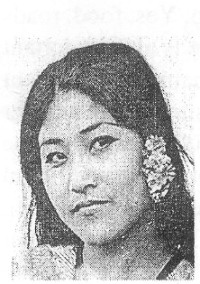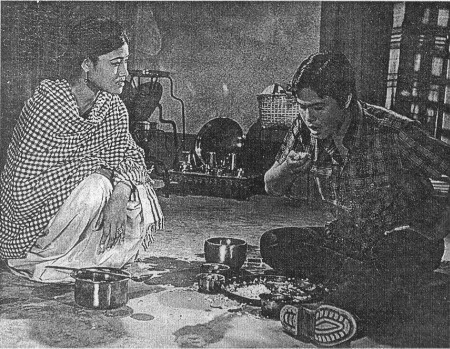WOMEN IN MANIPURI CINEMA
Yengkhom Roma *

Yengkhom Roma
It was April 9 in 1972. The first ever Manipuri feature film Matamgi Manipur, produced by Karam Monomohan Singh was mounted for the premiere. And as the packed house tensed, in anticipation for the screen to come alive, I was so nervous, for I did the lead role.
Birbabu portrayed Ibotombi, my brother-in-law in the film. He was the one who spoke the opening dialogue in Manipuri.
"What are we having for lunch, Iteima ?"
"Dal and mashed potato. It's Ekadashi today", I replied.
The audience thundered with laughter. I panicked. Perhaps something was wrong with the act, something terribly wrong. It was never expected. The producer, the director as well as the artistes never thought that the opening dialogue would be greeted like this. The same reaction persisted as long as the film was running, I was told.
Maibam Haricharan Singh, the founder member of Roop Raag, gave the best comment. He said, "To me, it didn't mattered whether the film was good or bad. I was thrilled, simply thrilled to hear the first Manipuri dialogue on the silver screen".
The World Cinema is today one hundred years old and the Manipuri cinema is just over twenty five. Much can be said on the contribution of women in Manipuri cinema. One might not expect of this article to coverall the aspects touching the multiple roles played by women in the progress of the Manipuri cinema.
It is a known fact that men used to play the female roles when the cinema first started in India. Women were not ready to act in films. This trend continued till some educated women came forward to join in films. Kamala Devi Chattopadhyay was one such lady. She is said to have portrayed the role of 'Vasant Sena' on screen. But this dearth of female artistes never handicapped the Manipuri cinema as such.
The comparatively new art form of cinema had the potential to strike instant rapport with the masses. Creative talent finds in cinema a really affective medium.
Even Manipur conceived the idea of making films way back in 1946. A group of theatre enthusiasts attempted to make a film based on the popular play Mainu Pemcha, in Hindi. Thambal Devi, the darling of Manipuri theatre, was in the title role. Another highly talented female artiste Ngangbi Devi was the playback singer for the film.

A classic Manipuri film
The challenge taken up by these two brave female artistes deserve applause. This first venture unfortunately did not make it to the silver screen. A big rush followed in the wake of Matamgi Manipur. Producers, directors and artistes with theatrical backgrounds strove at making film. The late actor-director, S.N. Chand produced
Brojehdragee Luhongba, which is based on a story by Lamabam Kamal, to become the first director of a feature film from Manipur.
But the filmmakers in Manipur had to work aganist heavy odds. Want of proper technical facilities, shoe-string budgets and a small market weighed down on the Manipuri cinema. Yet, a director like Aribam Syam Sharma and a writer like M.K. Binodini Devi could surprise the world with their clarity of vision and delineation of human based values blended in the social fabric of Manipur.
Manipur joined in the race of filmmaking in India seventy-five years late. Equipped with a sound theatrical, literary and artistic background, and a deep insight of human nature, but with little technical knowhow, our filmmakers strode ahead of the rest of the Country to earn the coveted Grand Prix at Nantes (France) for the first time in India. The film was Imagi Ningthem, based on a radio play written by M.K.Binodini, which the writer improved upon and adopted for a screenplay.
It was thus from the pen of a Manipuri female writer that a film was conceived and which went on to bag one of the most prestigious recognitions that the international film world would ever bestow to any institution. Aribam Syam Sharma, with the support of Kongbrailatpam Ibohal Sharma whose company X-Cine Productions produced the film, surprised filmdom, the world over, with Imagi Ningthem.
Thirty one Manipuri feature films have been made till date. None suffered for want of female artistes. Some theatre-groomed female artistes of yesteryears made indelible stamp on the Manipuri silver screen by their outstanding performances. Tondon Devi lent her singular charm to the success of Olangthagee Wangmadasoo. Manbi Devi made significant contribution towards the success of Ishanou and Saphabee. G.Ibeyaima Devi gave a superb performance in Yairipok Thambalnu. Lourembam Pishak Devi did stunningly well in Mayophygee Macha. And there are several others, too.
A group of young female artistes cropped up soon after. They were mostly cast in the main roles and did remarkably well with character roles. Rashi, Rajani, Jamini, Indira, Bedamani, Romola, Bhubaneshwori, Uma, Subadhani, Hemabati, Chandrashakhi, Memcha, Kiranmala, Devala, Sakhi, Kalpana, Shushila, Parvati, Sunanda, Ratnabala, Satyapyari, Bimola, Babita, Sabita, Nirmala, Narmada, Seema, Radhapyari and Sarjubala belong to this school. Almost all of them had theatrical background. Films with these female artistes have won awards galore in the national and the international fora. I had also the good fortune to belong to this genre.
It is worth mentioning that in the national level, Anoubam Kiranmala, the main actress in the film Ishanou, was honoured with the 'Special Mention' in the National Film Festival in 1991. In this context, the well-known filmcritic Phiroz Rangoonwala observed, "Anoubam Kiranmala, that superbly national actress of the Manipuri film Ishanou, really deserves the best acting award" (Screen - May 24, 1991, page 15).
Our women are generally associated with cinema in the capacity of artistes. Next comes playback singers followed by screen-playwrights and lyricists. But we have not seen any women director and technician as yet. Of the tally of thirty Manipuri feature films, counting from Matamgi Manipur to Khamba Thoibi, ten films had been written by women writers.
Another interesting fact is that during the last fifteen years or so, many female writers of Manipur are making outstanding contribution in the field of literature. Poems, short stories, novels, plays and, of course, screenplays flow from their pens. Yet others are involved with the media. The same is true of the tribal dialects. This trend is reflected in filmdom as well, I am sure. They are contributing in filmmaking, too. Their role in the evolution of our cultural history becomes all the more remarkable.
Another dimension of the Manipuri cinema is the small screen. Want of adequate fund for the celluloid has not deterred the creative urge of our film enthusiasts. They turned to the video as an alternative. This is visible among the tribals, too. Not less than a hundred and fifty video films has already been produced. Some are much acclaimed. The Tangkhul actress Sweety is now a big name on the small screen. R.C. Joycee is another much applauded Tangkhul actress. She starred in the film Mayophygee Macha.
Video filmmakers of Manipur were very lucky that two internationally established resource persons, Professor Ernest Gusella and Tomiyo Sasaki from New York had conducted a month-long workshop on "Hi-Tech Video" (Creative Video). M.K. Binodini had met the expert-couple at New York. They were visiting Jamia Milia Islamia for a four months' workshop sponsored by the Fulbright Foundation in March of 1993. M.K. Binodini had requested them to consider a workshop in Manipur. The time frame was too tight. The department of art & culture immediately took up the matter with the Foundation and the Foreign Department, Govt, of India. The workshop was ultimately held at the Manipur State Museum auditorium. Dr. K. Sobita, the curator of the museum was all help.
Ernie and Tomiyo normally conduct workshops for twelve participants. There were fifty-seven participants in the workshop. It was because they decided not to disappoint the youthful aspirants. The result was beyond expectations. Twenty appreciable films were made by the participants during the short span of one month. In fact, a woman writer like Binapani emerged out of the workshop as a resourceful film director.
It may be noted that the Manipur Film Development Corporation could organise workshops on different aspects so that Manipur film workers might acquaint themselves with the latest trends in filmmaking. Filmmaking in Manipur is a pretty hard proposition. Want of adequate equipment forces one to go to laboratories outside the state. The small size of the market results in minimum returns to the producers who cannot afford ample exposure of raw materials, and the artistes have to be satisfied with the limited exposure of films. Our producers suffer from lack of capital resources which compel them to limiting the scope of the film produced.
It is amazing that inspite of the odds and inconveniences, the contribution of this small state in the world cinema is recognised internationally. Sadly, our own state seems not to have given much serious thoughts to filmmaking. The state has not yet adopted a film policy to give incentives and the much needed boost to the filmmakers.
One might recall the statement made by Pierre Barroux, counsellorfor cultural, scientific and technical co-operation, French Embassy, when he came to participate in an international film festival in Manipur sometime back. He said, "The entire budget of your films is not enough to meet the travel expenditure involved in making our films. You don't have adequate lab facilities. We have all these. And yet we do not have the potential of your films, the force of the subject that you have in Ishanou. My wife witnessed Ishanou nine times. And she still wants to. Here we seek your co-operation. We could help each other a lot".
One often wonders why and how it is possible at all for our women to earn laurels in the national and international film arena, inspite of their want of adequate training. Our unique cultural heritage is surely the answer. Our women always take active roles in our folk rituals and religious festivities. These social institutions
probably grooms them into such sound artistic personalities. It is the ethos of our social institutions that train the psyches of our women for their eventual success
in the realm of cinema.
It is my firm belief that Manipuri cinema will surmount all these handicaps and shall attain still greater heights.
